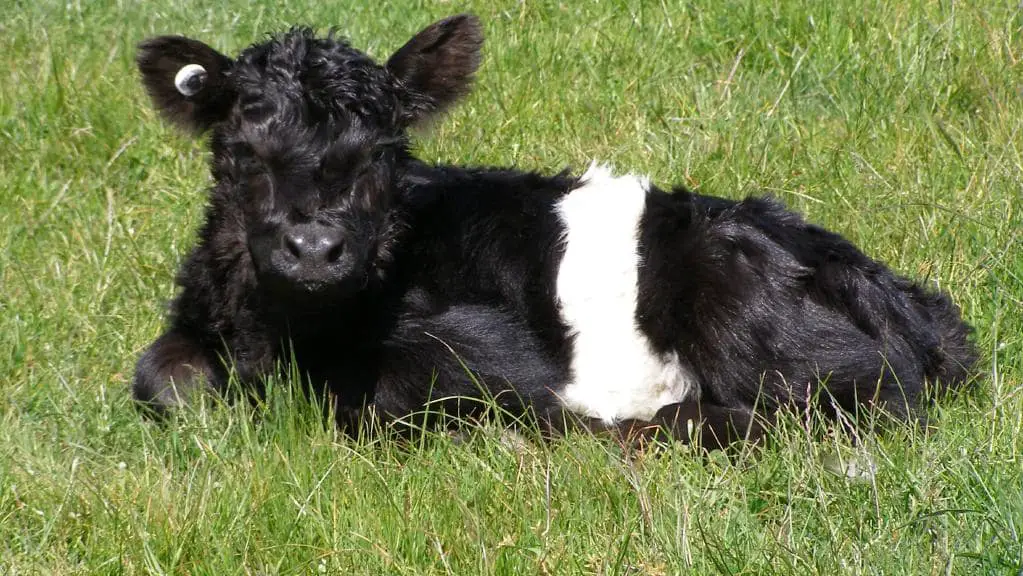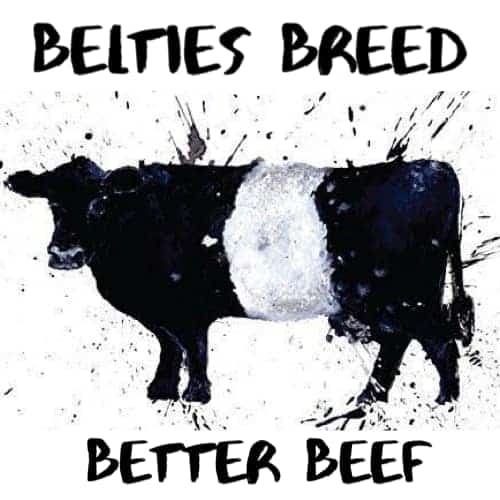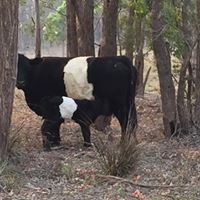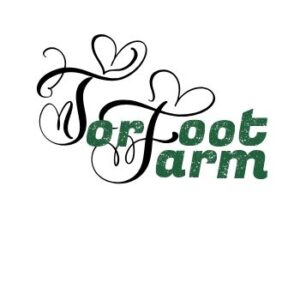
Belties, Oreo Cows, Panda Cows are all colloquial names for this wonderful breed of cattle, the Belted Galloway. This ancient breed of cattle was listed on the Rare Breeds List for several years as threatened but now are listed as recovering thanks to the work of breeders associations around the world.
The “Beltie” is naturally polled meaning they are born without horns and have striking colourings of black, red or dun, and no markings other than their characteristic white belly belt. For sheer eye appeal, no breed is more distinctive in the paddock and the term “Beautiful Belties” is often used.
Their hide of a “double coat ” of hair, consisting of a long, shaggy overcoat and a soft, thick undercoat, providing excellent insulation in cold, bleak weather and reducing the amount of feed intake required to maintain body weight. This trait makes them perfect for the climate at Torfoot Farm on the Granite Belt of Queensland Australia. Our cold winters and occasional snowdrifts are a challenge for most other breeds but our Beautiful Belties take it in their stride with ease.
The breed started and was developed in the Austere Hill Country in the Galloway area of South-West Scotland and is believed to have originated more than 300 years ago as the result of crossing the Galloway with the Dutch Lakenvelder.
Belted Galloways have several traits which will fit in with just about any crossbreeding program and the targeting of all domestic and export markets. Belted Galloway are known for a number of their rare and quality traits. Some of these traits are listed below:
Excellent Beef Qualities
Belted Galloway Beef has been shown in a research study conducted at the University of Guelph, Ontario Canada to have a total fat content of about 2%, an extremely low percentage. The same study showed that the Belted Galloway Beef tested only contained about 1% saturated fat. In addition, it showed that Belted Galloway beef had the same fat content as chicken and fish so it fits in well with a healthy diet. Belted Galloway beef is exceptionally tender, full of flavour and juicy and were the winners of the 2003 Sydney Royal Show “Beef Taste Test”.
Data collected in the U.S. has shown that the beef dresses out at 60 – 62% of live weight making it a very profitable breed. As a cattle breed they are excellent foragers meaning that the cost of feeding in harsh climates is reduced and, their ability to convert poor quality feed to muscle tone is excellent. Galloway beef is rich in linoleic acid, which reduces the dangerous type of cholesterol (LDL), prevents thrombosis and therefore protects coronary vessels.
Statistics
A mature Belted Galloway Bull can weigh between 815 and 955 kilograms although some may be smaller and others larger. A cow ranges from 400 to 600 kilograms, newborn heifers weigh, on average around 30 kilograms and a bull calf can be 35 kilograms and sometimes more. “Beltie” calves weaned at 205 days, were about one half their mother’s weight. Due to their thick coats Belted Galloways need 25% less feed than standard breeds. In fact, they will continue to gain weight on rations that others would lose weight on. Of the 11 breed groups included in the study by Clay Animal Research Center, Nebraska, USA, the Galloways recorded the highest weaning percentage (95.5%), the highest calf survival percentage (95.2%), and an outstandingly low incidence of calving difficulty (0.8%).

Fertility
The Belted Galloway is an extremely fertile breed; the cows are long-lived (some up to 20 years), regular breeders, and are noted for their ability to produce a healthy, well-nourished calf at weaning, even in the harshest of conditions. The fertility cycle is 21 days approximately and they do well both under Artificial Insemination and Natural Increase. Some Belted Galloways have had two separate calves in one year. One cow in Australia has even produced three lots of twins in a row. Strong hybrid vigor due to the purity of the breed means they rarely miss a calving year.
Easy Calving
Belted Galloway are well known for their ease of calving producing a live calf every year. The “Beltie” Breed is naturally polled and when crossed with another breed it will prevent the growth of horns in virtually all cases. We have experimented with a Wagyu Heifer and frequently suggest to first time breeders to use Beltie Bulls for their first calving heifers due to the low birth weights. This trait is very important in birthing and helps the new mother to pass the calf. Belted Galloways rarely need birthing assistance and prefer to go off alone and birth in private.
Mothering
Belted Galloways cows generally make excellent mothers. They are protective of their calves and each other. We have often witnessed one cow minding several calves while the other mothers are off feeding or drinking. A Belted Galloway Cow will drink twice as much as normal when feeding her calf and can easily be taught to allow the farmer the first 2-3 Litres of milk each day while still supporting a healthy calf. The cows are renowned for their mothering ability, producing enough rich milk to wean a large and healthy calf at around 205 days. The maternal attributes of the Galloway cow come out tops in a study at the famous Clay Animal Research Center, Nebraska, USA. Eleven breed groups were tested for their ability to give birth and rear their calves.

Adaptability
“Belties” are able to adapt to a wide variety of climatic conditions. They have good foraging abilities, ensuring that they thrive where other breeds fail. The coat is shed in hot weather, thus making the “Beltie” a highly adaptable and versatile breed for a variety of climatic conditions. Due to the thick outer coat rainy conditions simply are deflected off the coarse outer layer, keeping them dry at skin level and able to maintain their body temperatures extremely well.
Handling
Belted Galloway breeders find that Belted Galloway possess a quiet disposition and are easily handled when managed properly. They do have personality though like most animals and respond well to routine.
We call our girls from the neighbouring 40 acres and they will come running at the mere suggestion of a treat or extra bale of hay.
Disease resistant
The breed has evolved in a harsh environment, resulting in high disease resistance and the ability to survive in the toughest of conditions. Belted Galloway breeders find that their cattle are more resistant to pink eye, insects and foot problems than many other breeds. They respond well to organic methods of animal husbandry as well as the typical commercial operations. They generally have fewer birth defects as well.
Uses
Belted Galloways are often used as dairy cows due to their docile nature and compliance with the process. Cheese products being particularly popular from as early as the 12th Century. Their beef has also been likened in quality to that of the prized Wagyu Beef the Japanese love so much. Due to the good forage conversion, Belties are often used to rehabilitate poor quality pastures in a system known as Restoration Agriculture. They also make great house cows or hobby farm type pets.
Conclusion
This breed of cattle is as has already been discussed a most versatile and solid breed. They are distinctive in any paddock and draw the attention of neighbours and tourists alike. There is no other animal quite like them and I suggest once you have seen one up close you like me will be totally in love with them.
Torfoot Farm Belted Galloways is a registered breeder with the Belted Galloway Association of Australia. We provide commercial stock to hobby farmers, butchers and meat processors each year as well maintain a registered breeding herd.
If you are interested in purchasing any of our cattle please drop us a line via our contact page.
www.beltedgalloway.org.au
https://www.thatsfarming.com/news/belted-galloway-cattle
https://en.wikipedia.org/wiki/Belted_Galloway
http://www.thebeefsite.com/breeds/beef/9/belted-galloway/
https://www.dpi.nsw.gov.au/animals-and-livestock/beef-cattle/breeding/beef-cattle-breeds/galloway
https://www.gallowaycattle.com.au/breeds/belted-galloway

